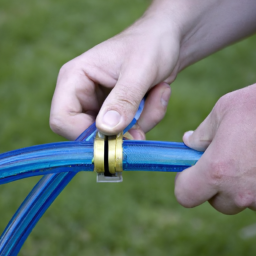How To Cut A Garden Hose Tips Tricks
Table of Contents []
How To Cut A Garden Hose
Introduction
A garden filled with flower beds and lush greenery is often the pride of most homes. It's often the first part of the house one notices when entering. Garden hoses are an integral part of keeping our gardens healthy and thriving. Not only do they carry water, but they are also used for cleaning purposes. This article aims to provide a helpful guide to easily cut a garden hose, backed by relevant research and suggested techniques scholars and professionals have put forward.
How to Select the Right Garden Hose
Before cutting a garden hose, it's essential to select the right one. Important characteristics that need to be considered include pressure rating, length, material, and diameter. The pressure rating is important as it helps guide a user in the right direction when selecting the right garden hose for that application. Length is important, as the user needs to select the right one for their application, and not buy too much or too little. Material is important as some materials are more durable than others. Lastly, the diameter of the hose helps determine the pressure rating one might use, and help the user make a wise decision.
Cleaning the Garden Hose
Once the right garden hose is selected it's time to clean it. Cleaning a garden hose is important for two reasons: it ensures the hose is free of blockages, and it can help the user identify potential areas that may need repairs. Ensuring the hose is clean can be done by simply running water through the hose and welding it, or using an appropriate cleaner or hose brush.
Measuring the Garden Hose
After the hose is cleaned, the next step is to measure the length of the garden hose. This is important as it ensures one cuts the right length to ensure the application is within the right length, and to ensure the user has the right length of hose for that application.
Cutting the Garden Hose
This is a crucial step, as it is essential in ensuring the hose works correctly and is not too short or too long. There are several methods that can be used to cut the garden hose. One can either use a sharp utility knife, straight scissors, sharp shears, and a mm/inch tape as a guide to cut. It is the user's discretion on which tool they use, depending on the type of garden hose.
Attaching Fittings
Once the garden hose is cut, it is time to attach the fittings. Depending on the type of garden hose, the user may require different fittings to attach them securely and prevent water leakage. It is recommended users use a screw with thread sealant for normal-sized garden hoses, and a crimping tool for larger hose sizes.
Repairing the Garden Hose
Occasionally, the garden hose may require repair due to wear and tear, cracks, tears, and other factors. To repair the garden hose in this instance, a patch kit and/or a mender will be required. The patch kit is used to repair the inner lining of the hose, and a mender is used to cover the break.
Storing the Garden Hose
When storing the garden hose, it's important to drain the water out of the hose. After draining the water, coil the hose and store it in a cool and dry place. This will help ensure the hose is safe and secure, and free from any external damage.
Maintaining the Garden Hose
Maintaining the garden hose is important as it helps ensure the life of the hose is extended. This can be done by regularly cleaning the garden hose, inspecting it for any cracks or signs of deterioration, and lubricating the fittings.
Summary
Cutting a garden hose requires understanding the important characteristics when selecting one, cleaning the hose, measuring it, cutting it, and attaching fittings. It's also important to repair it when needed, store it properly, and maintain it. With the right techniques and knowledge, cutting a garden hose is an easy task.

Previous Page
Next Page